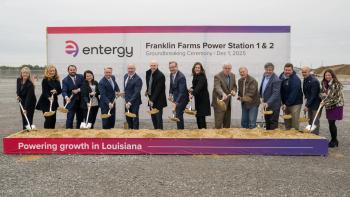
DGT-5: Doosan's 5 MW gas turbine
Performance testing of the 5 MW gas turbine being developed by Doosan
The DGT-5 is a 5 MW gas turbine being developed by Doosan. Below are excerpts from a paper presented by Sooyung Kim and Reewok Ryu of Doosan at the ASME/IGTI show in 2011 in Vancouver.
With the shift in the role of gas turbine from base to supplementary, CHP application based on small powered gas turbine utilizing biogas or syngas as its fuel is expected to increase in the future. In this context, this paper describes the development result of 5MW gas turbine engine for CHP application. It can be operated with LNG or syngas of low LHV fuel. Originally, the engine was designed for LNG as its primary fuel, but since the importance of syngas power generation market will be increasing in the future, a complementary work for modification of combustor part has been carried out and has been tested. However, this paper deals with the parts developed with the use of LNG fuel. The test result of emission characteristics meets the standards required in Korea. The development has been made through the cooperation of Doosan Heavy Industry (DHI, Korea) and Zory-Mashproekt (Ukraine).
For the development of DGT-5 gas turbine engine, the design point selected is considered fairly competitive compared with similar gas turbines in the market today. Selection of the rotating speed of the gas generator is made based on mass flow rate of the prototype model UGT-2500 gas turbine engine with stress limit in the centrifugal compressor taken into account.
A combustor consists of central and peripheral swirl nozzles as well as ejector installed in the central swirl nozzle. Central swirl area and liner are designed based on the combustor prototype UGT15000 engine to utilize the stable combustion characteristics already proven through commercial operations [4]. The designed scheme of the combustor is shown in Fig. 3. Eight of can type reverse-flow combustors are installed in radial direction. Combustion liners have convective air cooling on external surface convective-film cooling on the internal surface. Transient piece is designed to provide smooth transition of hot gas flow from combustor exit to turbine with a minimum pressure loss.
Three stage axial type turbine is designed with due consideration of cooling system calculation. Secondary air system analysis is carried out to meet turbine performance with adequate air mass flow satisfying turbine parts strength limit. First stage rotor and stators, second stators are cooled by compressed air extracted from the compressor stages, and turbine rotor parts are of disk type design.
At this time of development, both front and rear bearings are of roller bearing type, but the front bear will be replaced with journal bearing in the commercial stage. Reduction gear box is employed to decrease the rotation speed of the gas generator and at the same time to increase the torque for transferring the power from the engine to the generator. The gear box is originally designed as 2 stages of 3 power transferring axial gears type. Starting power regime is estimated to confirm the starting time to the idle condition as well as to develop the control algorithm of starting system for the entire starting process. It takes about three minutes from initial start to the nominal rotating speed.
Throughout the development project four gas turbines were to be manufactured and two of them will be wasted in the process to confirm the design parameters through experiments. Third and fourth of the gas turbines will go through endurance tests after modifications are made to the engines. The fourth engine is scheduled to be installed in the biogas power plant at Kimpo, Korea to accumulate field test experience. Performance test of the first engine was done from November 2009 until April. 2010. The second engine had been tested from May 2 until September 2010.
The test result of power output was a bit lower than the target showing 4.97 compared with 5.25 MW of the target at ISO condition. After the test, a thorough investigation of the result found out that the defects came from several different locations such as centrifugal compressor part, diffuser, and combustor casing.
From the test result of the developing gas turbine engine, the followings are noticed; 1. it is necessary to measure the flow rate to better define the turbine flow rate, 2. the precise measurements of the turbine flow passage area and compressor to better define the air leakage during the operation regime will be necessary, 3. the application of the shrouded impeller is considered essential to meet the target performance of the engine. 4. the design modifications to reduce the total pressure losses occurring from compressor diffuser exit to rhe first stage turbine inlet must be examined thoroughly and measures to overcome these obstacles should be taken.
Newsletter
Power your knowledge with the latest in turbine technology, engineering advances, and energy solutions—subscribe to Turbomachinery International today.





